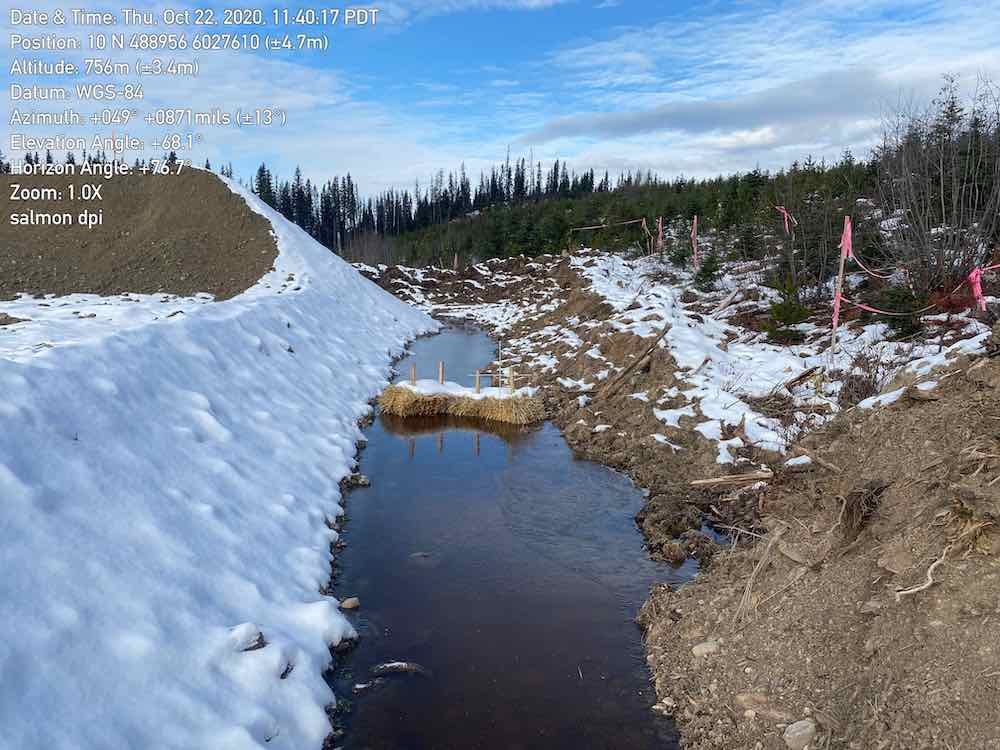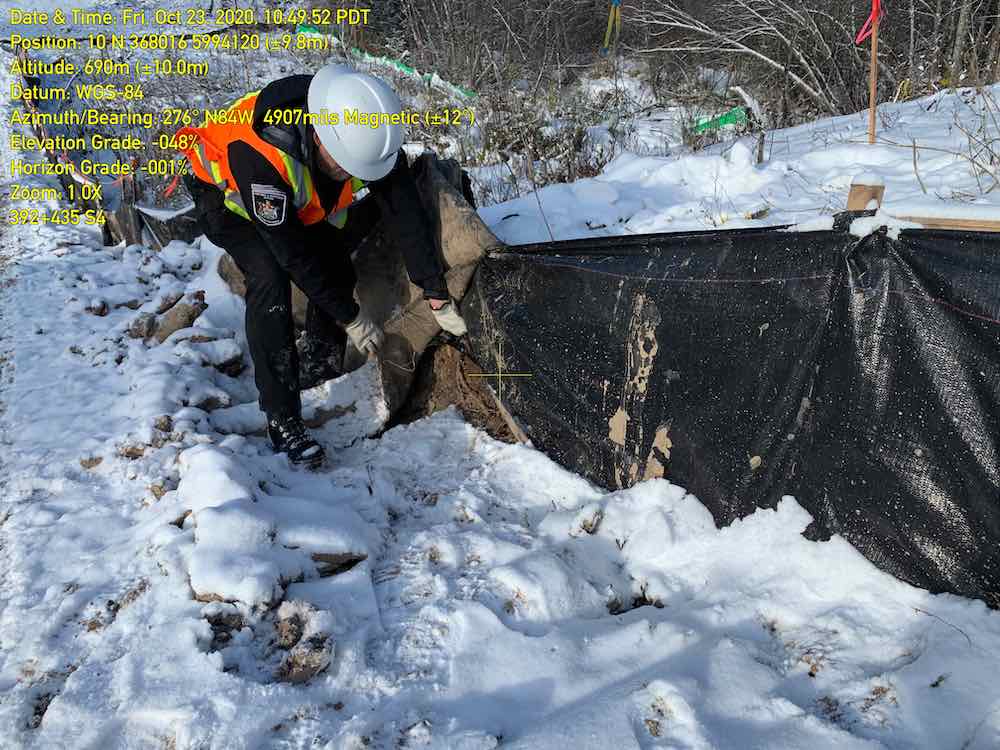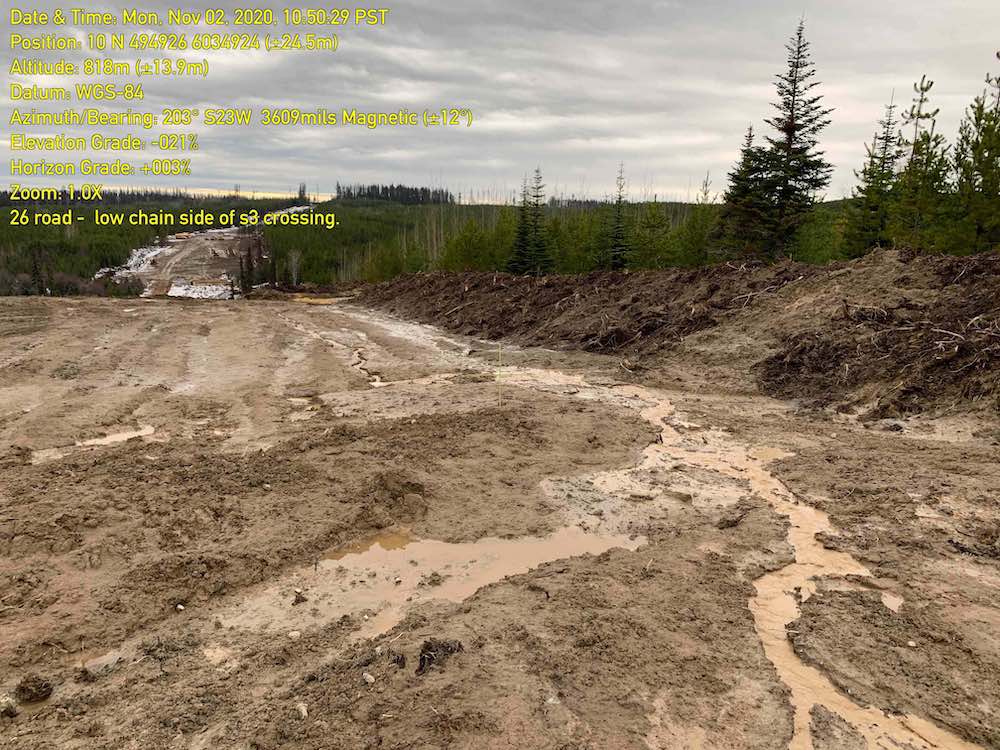Coastal GasLink has been given until Jan. 22 to hire an independent auditor to address erosion and sediment control issues on its pipeline route across northern B.C.
The requirement is part of an order by B.C.’s Environmental Assessment Office.
The Dec. 8 order says Coastal GasLink must do more to control sediment flowing from its construction sites into environmentally sensitive areas, like watercourses and wetlands, by stabilizing banks, creating working erosion control measures and maintaining them after construction is completed.
Compliance and enforcement officers visited sections of the 670-kilometre pipeline and found contractors weren’t complying with erosion-control measures in its Environmental Management Plan, allowing sediment to flow into fish-bearing streams.
That risks damaging fish habitat and introducing contaminants to watersheds, researchers warn.
The independent erosion and sediment control auditor hired by the company must submit a plan for monitoring compliance with the order by Feb. 4 and provide reports every two weeks to the Environmental Assessment Office starting Feb. 15. Those reports will not be reviewed by Coastal GasLink, the order stipulates.*
The company was also ordered to pay a $10,000 inspection fee.
The inspections, which took place in late October and early November, focused on about 400 kilometres of the pipeline route north and west of Prince George. Compliance and enforcement officers visited sites in five of the project’s eight sections, stretching from Groundbirch in the province’s northeast to Endako, 70 kilometres west of Vanderhoof.
The EAO report noted the company had completed the required erosion and sediment control plan, which is described as a “high-level planning document.”
But mitigation measures in the plan were not being implemented and Coastal GasLink had failed to do more detailed planning to prevent pollution, the office said.
In four of the sections inspected, EAO staff found that required site-specific plans for high-risk areas and activities were not followed and measures intended to prevent run-off from entering waterways, such as fencing, berms and straw bales, were not properly installed or maintained.

In another section west of Prince George, the inspection found there were no site-specific erosion and sediment control plans and there were “various examples of sediment fencing installed incorrectly and/or at risk of failing.” Construction, including watercourse crossings and work near wetlands, was taking place during the inspection, the report noted.
In addition, it found no contractor-specific plan for erosion and sediment control was in place in the section.
In a response to the EAO, parts of which were included in the report, Coastal GasLink said it was in the process of reviewing an erosion and sediment control plan that it received from prime contractor Pacific Atlantic Pipeline Construction in November.
Inspectors described being onsite when a large steel girder, intended to serve as a bridge, was dropped into a fish-bearing stream 70 kilometres north of Prince George. Instead of launching the required water quality monitoring, machine operators started to retrieve the girder until EAO staff intervened and noted the correct procedures.
Inspectors noted that at the same site an area roughly 50 by 150 metres had been stripped of vegetation and left exposed, allowing run-off to flow into the stream.
“Water from snow melt and recent rain events was observed to be actively eroding the right of way and has caused sediment from the right of way to transport downslope towards the watercourse,” the report says. It adds that equipment and personnel were not immediately made available to fix the problems as required in the Environmental Management Plan.
“The foreman chose to continue work and contractor personnel and equipment were not made available until stop work was implemented as a result of the failed girder launch and subsequent in-stream work requirements being triggered,” the report reads.
As “sediment-laden project water” continued to flow into the stream, inspectors describe observing the steel girder being dropped into the water.
EAO officers had to intervene and tell Coastal GasLink and contractor managers “that in-stream work requirements had been triggered,” the report says.

While muddy water might not seem an immediate environmental threat, sediment can be dangerous to aquatic life, according to researchers at the University of Northern British Columbia.
“Fine sediment getting into creeks, particularly small creeks, is a major concern on a variety of different levels,” says Philip Owens, a professor in UNBC’s environmental sciences program. The U.S. Environmental Protection Agency identifies sediment as a main pollutant for streams south of the border.
“If that sediment is also getting into creeks, then there’s a problem that there’s likely to be a pollution-related issue.”
Owens and Ellen Petticrew, a professor in UNBC’s geography program, have spent the past seven years researching the origins of fine sediment in sensitive aquatic habitats of the Nechako watershed west of Prince George.
The project is looking at impacts on salmon and Nechako white sturgeon, an endangered species unique to the watershed. While sedimentation, which clogs spawning beds, is an issue in itself, they say that it often carries bigger problems — namely, contaminants like heavy metals, fertilizers and PCBs.
“The fine silts and clays have the ability to adsorb nutrients and other contaminants and move them throughout the aquatic environment and into the riverbed,” Petticrew says. “This vector issue becomes more of a problem around construction sites and following pipeline leakages or spills as it can exacerbate the problem of contaminant transport.”
Owens adds that it’s not uncommon to see non-functioning erosion control measures associated with industrial projects, including logging and mining, and that the cumulative effects of the projects are concerning.
“If you’re adding a little bit of sediment to each of these creeks, and those creeks obviously flow into a bigger river… collectively, it is quite considerable,” he says.
The effectiveness of sediment-control measures hinges on the quality and frequency of monitoring and water testing, they say. In the case of Coastal GasLink, that will be set out in the plan to monitor and report on compliance that’s due later this month.
In total, the report found Coastal GasLink to be non-compliant in all but one of 17 items it reviewed.
It criticized the company’s approach to reducing environmental impact by managing seasonal work schedules — things like avoiding work that leaves soils exposed during spring runoff — but said its compliance was “not determined.”
“In some locations, EAO was informed that the next phase of work was not scheduled to take place until the Spring of 2021. In the meantime, the surface materials on the right of way would be left exposed and at risk of erosion and sediment transport,” the report says.
“Thoughtful winterizations, minimizing exposed soils that will be subject to spring melt and installing measures proactively before freezing did not take place.”
The EAO stopped short of calling Coastal GasLink’s actions non-compliant because its response notes that the erosion and sediment control plan outlines “best practices” and not requirements.
“While Coastal GasLink agrees that those practices may not yet have been properly implemented to their entirety at the time of the inspection, it still expects that those practices will be considered by its Prime Contractors and their Qualified Professionals,” the company said.
The inspection report also includes infractions for an unattended work vehicle left idling for more than an hour-and-a-half, improperly stored food waste and a lack of required signage near watercourses.
In a separate inspection report, also posted in December, compliance and enforcement officers found Coastal GasLink to be non-compliant in water-quality monitoring and erosion and sediment control at a settlement pond at the Lejac multi-use site, also known as Little Rock Lake Lodge work camp. Water from the settlement pond was flowing from the site into Fraser Lake.
This summer, the EAO ordered Coastal GasLink to stop construction within 30 metres of protected wetlands after an inspection found the company cleared areas without completing the required surveying and planning.
The company did not respond to The Tyee’s requests for an interview.
*Story amended on Jan. 11 at 2:42 p.m. to add updated information from the Environmental Assessment Office. The office said today that deadlines for action on the report's orders had been extended at Coastal GasLink's request. ![]()
Read more: Energy, Environment
















Tyee Commenting Guidelines
Comments that violate guidelines risk being deleted, and violations may result in a temporary or permanent user ban. Maintain the spirit of good conversation to stay in the discussion.
*Please note The Tyee is not a forum for spreading misinformation about COVID-19, denying its existence or minimizing its risk to public health.
Do:
Do not: